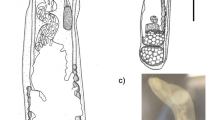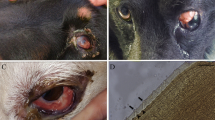Abstract
Following a recent incident of human philophthalmosis in Israel, the intramolluscan larval trematode fauna in snails randomly collected from the suspected water source was checked. Of the snails examined, onlyMelanopsis praemorsa shed cercariae, including aPhilophthalmus cercaria. To identify the philophthalmid species involved, chicks were experimentally infected with metacercariae of the trematode, subsequently yielding mature trematodes resembling those ofP. palpebrarum. The majority of trematodes obtained, whether from one-worm infections or from multiple-worm infections resulting in a single trematode in one of the eyes, were relatively small and showed only immature eggs in their uteri. This finding suggests that the existing descriptions of two species ofPhilophthalmus purportedly harbouring eggs with non-oculate miracidia, namelyP. palpebrarum andP. nyrocae, are actually based on immature specimens from one-worm infections that precluded cross-fertilisation. If this be true, then all species of the genusPhilophthalmus produce eggs that, when mature, contain oculate miracidia. The species encountered in Israel is thus most likelyP. palpebrarum.
Similar content being viewed by others
References
Alicata JE, Ching HL (1960) On the infection of birds and mammals with the cercaria and metacercaria of the eye-fluke,Philophthalmus. J Parasitol 46 [Suppl]:16
Ching HL (1961) The developmental and morphological variation ofPhilophthalmus gralli Mathis and Leger, 1910 with a comparison of species ofPhilophthalmus Looss, 1899. Proc Helminthol Soc Wash 28:130–138
Dissanaike AS, Bilimoria DP (1958) On an infection of a human eye withPhilophthalmus sp. in Ceylon. J Helminthol 32:115–118
Fried B (1962) Growth ofPhilophthalmus sp. (Trematoda) in the eyes of chicks. J Parasitol 38:395–399
Gutierrez Y, Grosniklaus HE, Annable WL (1987) Human conjuctivitis caused by the bird parasitePhilophthalmus. Am J Ophthalmol 104:417–419
Howell MJ, Bearup AJ (1967) The life histories of two bird trematodes of the family Philophthalmidae. Proc Linn Soc N S W 92:184–192
Ismail NS, Issa IM (1987) Life cycle ofPhilophthalmus gralli (Mathis and Leger, 1910) (Trematoda: Philophthalmidae) in Azraq Oasis, Jordan. Jpn J Parasitol 36:53–62
Ismail NS, Saliba EK (1985) Studies on larval stages of digenetic trematodes ofMelanoides tuberculata (Muller) snails from Azraq Oasis, Jordan. Riv Parassitol 46:263–271
Kalthoff H, Janitschke K, Mravak S, Schopp W (1981) Ein ausgereifter Saugwurm der GattungPhilophthalmus unter der Bindehaut des Menschen. Klin Monatsbl Augenheilkd 179:373–375
Lang Y, Weiss Y, Garzozi H, Gold D, Lengy J (1993) A first instance of human philophthalmosis in Israel, J Helminthol (In press)
Looss A (1899) Weitere Beiträge zur Kenntnis der Trematoden-Fauna Aegyptens, zugleich Versuch einer natürlichen Gliederung des GenusDistomum, Retzius. Zool Jahrb Syst 12:521–784
Looss A (1907)Philophthalmus nocturnus nov. sp. Centralbl Bakteriol Parasitenkd Infektionskr 43:479–480
Mathis C, Legér M (1910) Douve oculaire de la poulle. Bull Soc Pathol Exot 3:245–251
Markovic A (1939) Der erste Fall von Philophthalmose beim Menschen. Arch Klin Exp Ophthalmol 140:515–526
McDonald ME (1981) Key to trematodes reported in waterfowl. United States Department of the Interior, Fish and Wildlife Service, Washington, D.C.
Mimori T, Hirai H, Kifune T, Inada K (1982)Philophthalmus sp (Trematoda) in a human eye. Am J Trop Med Hyg 31:859–861
Osikovski E, Mikhov L, Vasilev I, Kanev I (1990) Comparative investigations on the water soluble proteins ofPhilophthalmus representatives from Bulgaria, Georgia S.S.R., U.S.S.R. and Vietnam. Khelminthologiya 28:58–65
Penner LR, Fried B (1963)Philophthalmus hegeneri sp. n., an ocular trematode from birds. J Parasitol 49:974–977
Swarnakumari VGM, Madhavi R (1992) Growth, development and allometry ofPhilophthalmus nocturnus in the eyes of domestic chicks. J Helminthol 66:100–107
Yamaguti S (1934) Philophthalmidae Travassos, 1921.Philophthalmus nyrocae n. sp. Jpn J Zool 5:552–554
Yamaguti S (1958) Systema helminthum, vol I. The digenetic trematodes of vertebrates, parts 1–2. Interscience Publishers, New York
Author information
Authors and Affiliations
Rights and permissions
About this article
Cite this article
Gold, D., Lang, Y. & Lengy, J. Philophthalmus species, probablyP. palpebrarum, in Israel: description of the eye fluke from experimental infection. Parasitol Res 79, 372–377 (1993). https://doi.org/10.1007/BF00931825
Received:
Accepted:
Issue Date:
DOI: https://doi.org/10.1007/BF00931825




